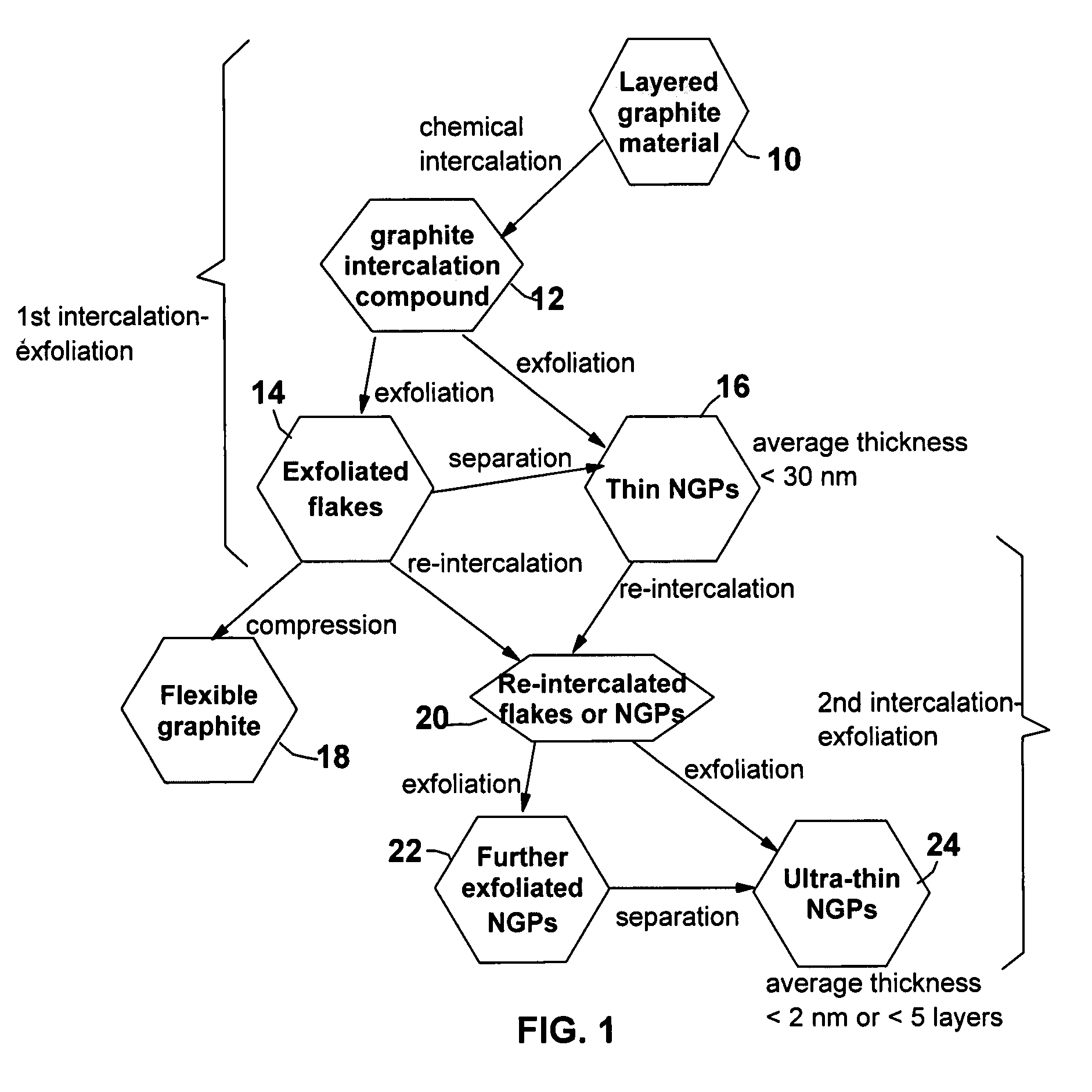Environmentally benign graphite intercalation compound composition for exfoliated graphite, flexible graphite, and nano-scaled graphene platelets
a graphene platelet and compound composition technology, applied in the direction of electrolysis process, electrolysis components, chemistry apparatus and processes, etc., can solve the problems of high material cost, inability to mass produce nano-scaled platelets, and high cost of cnts
- Summary
- Abstract
- Description
- Claims
- Application Information
AI Technical Summary
Benefits of technology
Problems solved by technology
Method used
Image
Examples
example 1
Hydrogen Peroxide-Assisted, Formic Acid-Intercalated Graphite and Nano-Scaled Graphene Platelets (NGPs) from Highly Oriented Pyrolytic Graphite (HOPG) Flakes
[0073]Two grams of HOPG flakes of approximately 20 μm in size, were immersed in a mixture of 2 L of formic acid and 0.1 L of hydrogen peroxide at 45° C. for 24 hours. Following the chemical oxidation intercalation treatment, the resulting intercalated flakes were washed with water and dried. The resulting product is a formic acid-intercalated graphite compound.
[0074]Subsequently, approximately ½ of the intercalated compound was transferred to a furnace pre-set at a temperature of 600° C. for 30 seconds. The compound was found to induce extremely rapid and high expansions of graphite crystallites with an expansion ratio of greater than 200. Further separation of exfoliated flakes using a Cowles shearing device led to the formation of NGPs. The thickness of individual platelets ranged from two graphene sheets to approximately 45 g...
example 2
NGPs from Natural Graphite Flakes Intercalated with a Mixture of Acetic Acid and Hydrogen Peroxide
[0078]Two grams of natural flake graphite having a particle size of 50 mesh were subjected to the same chemical oxidative intercalation conditions described in Example 1, with formic acid replaced by acetic acid. Following the intercalation treatment, the resulting intercalated flakes were washed with water and dried. Then, the intercalated compound was transferred to a furnace pre-set at a temperature of 500° C. for 45 seconds. The compound was found to induce extremely rapid and high expansions of graphite crystallites with an expansion ratio of greater than 100. After a mechanical shearing treatment in a laboratory-scale Cowles rotating blade device for 15 minutes, the resulting NGPs exhibit a thickness ranging from three graphene sheets to approximately 50 graphene sheets (average of 25 sheets or approximately 8.5 nm) based on SEM and TEM observations. Re-intercalation of these NGPs...
example 3
Repeated Interaction, Exfoliation, and Separation Steps of Graphite Oxide
[0079]Graphite oxide was prepared by oxidation of graphite flakes with sulfuric acid, nitrate, and potassium permanganate according to the method of Hummers [U.S. Pat. No. 2,798,878, Jul. 9, 1957]. Upon completion of the reaction, the mixture was poured into deionized water and filtered. The sample was then washed with 5% HCl solution to remove most of the sulfate ions and residual salt and then repeatedly rinsed with deionized water until the pH of the filtrate was approximately 7. The intent was to remove all sulfuric and nitric acid residue out of graphite interstices. The slurry was spray-dried and stored in a vacuum oven at 60° C. for 24 hours. The interlayer spacing of the resulting laminar graphite oxide was determined by the Debye-Scherrer X-ray technique to be approximately 0.73 nm (7.3 Å), indicating that graphite has been converted into graphite oxide.
[0080]The dried intercalated graphite oxide powde...
PUM
 Login to View More
Login to View More Abstract
Description
Claims
Application Information
 Login to View More
Login to View More - R&D
- Intellectual Property
- Life Sciences
- Materials
- Tech Scout
- Unparalleled Data Quality
- Higher Quality Content
- 60% Fewer Hallucinations
Browse by: Latest US Patents, China's latest patents, Technical Efficacy Thesaurus, Application Domain, Technology Topic, Popular Technical Reports.
© 2025 PatSnap. All rights reserved.Legal|Privacy policy|Modern Slavery Act Transparency Statement|Sitemap|About US| Contact US: help@patsnap.com



